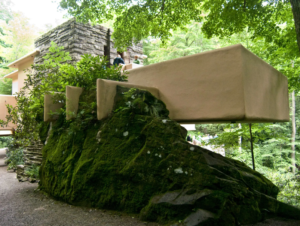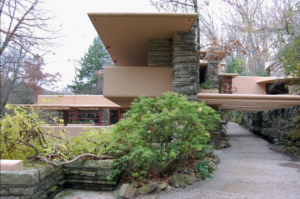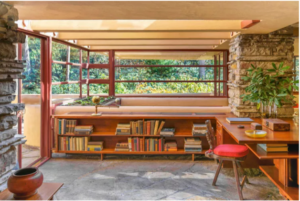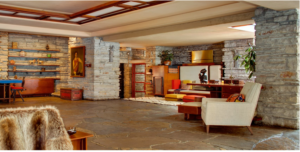Man and nature as one, living in coexistence and common rhythm, was the fundamental philosophy of the greatest American architect, Frank Lloyd Wright, who was a proponent of organic architecture. His organic buildings were in harmony with the location, time and occupants.

Frank Lloyd Wright (1867 – 1959)
The Fallingwater House (1936–1939) is considered the most iconic of all Wright’s creations and the main achievement of his organic architecture. The house was designed for the wealthy Kaufmanns, who owned the largest department store in Pittsburgh and were known for their refined taste. They met Wright at his architectural studio and school at Taliesin, which their son attended. They wanted a weekend house, a retreat that celebrated the landscape in an innovative way.

The client’s love of Bear Run’s cascading waterfalls inspired the architect to envision the layout of the house, contrary to the Kaufmanns’ expectations, by placing it directly above the falls. The clients strongly opposed to this at the beginning, but later realized that the architect had enabled them to live with the waterfall, hear it, and not just be its observers.

The Fallingwater House is known for its bold design. Wright followed the natural pattern of the falls; the house grows out of the rocky landscape, the cantilevered sandstone terraces hover over the falls, drawing attention to the water while respecting its space.

He designed it around the fireplace, which is the starting point and the anchor of home. The fireplace is cut into the rock and thus the waterfall is physically present in the house. Low ceilings give a feeling of shelter, the interior opens to the landscape with glass walls. Nature thus enters the house and at the same time invites the residents outside. It is no coincidence that the size of the outdoor terraces is almost the same as the size of the indoor spaces.

In building the house, Wright collaborated with local craftsmen. He used materials that are the essence of his organic architecture – stone, concrete, steel, glass and wood. In order to create a uniform and organic composition, he used only two colours developed together with the company from Pittsburgh – light ocher for the concrete and Cherokee red for the steel. Wright furnished the interior with built-in and freestanding furniture he designed specifically for Fallingwater.

The building blends into the surrounding landscape, but is nevertheless a bold and noticeable structure among the trees. It served as a family vacation home for a quarter of a century, and in 1963, his son Edgar Jr. along with the land, donated it to the non-profit organization Western Pennsylvania Conservancy in Pittsburgh, which opened it to the public a year later.

The American Institute of Architects has named the Fallingwater House as one of the most important American structures of all time and is protected as a National Historic Landmark. It gained worldwide fame even before it was finished and is still considered a landmark in modern architecture. In 2019, UNESCO listed it as a World Cultural and Architectural Heritage Site, along with seven other buildings designed by architectural genius Frank Lloyd Wright.







